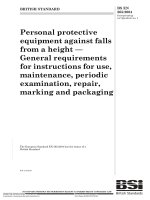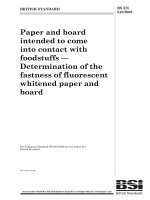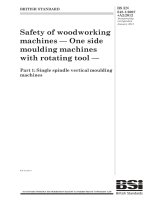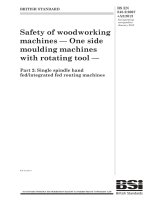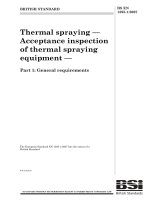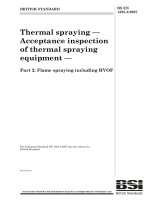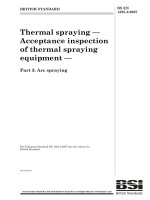Bsi bs en 62056 53 2007
Bạn đang xem bản rút gọn của tài liệu. Xem và tải ngay bản đầy đủ của tài liệu tại đây (2.85 MB, 150 trang )
BS EN
62056-53:2007
BRITISH STANDARD
Electricity metering —
Data exchange for
meter reading, tariff
and load control —
Part 53: COSEM application layer
The European Standard EN 62056-53:2007 has the status of a
British Standard
ICS 35.100.70; 91.140.50
?? ? ? ????? ??????? ??? ?? ???????? ? ?? ? ?? ?? ?? ?????? ? ?? ? ? ?????? ? ???
?
?
?
?
?
?
?
?
?
?
BS EN 62056-53:2007
National foreword
This British Standard was published by BSI. It is the UK implementation of
EN 62056-53:2007. It is identical with IEC 62056-53:2006. It supersedes
BS EN 62056-53:2002, which will be withdrawn on 1 February 2010.
The UK participation in its preparation was entrusted to Technical Committee
PEL/13, Electricity meters.
A list of organizations represented on this committee can be obtained on
request to its secretary.
This publication does not purport to include all the necessary provisions of a
contract. Users are responsible for its correct application.
Compliance with a British Standard cannot confer immunity from
legal obligations.
This British Standard was
published under the authority
of the Standards Policy and
Strategy Committee
on 30 June 2007
© BSI 2007
ISBN 978 0 580 50854 7
Amendments issued since publication
Amd. No.
Date
Comments
EN 62056-53
EUROPEAN STANDARD
NORME EUROPÉENNE
EUROPÄISCHE NORM
April 2007
ICS 91 .1 40.50; 35.1 00.70
Supersedes EN 62056-53:2002
English version
Electricity metering Data exchange for meter reading, tariff and load control Part 53: COSEM application layer
(IEC 62056-53:2006)
Equipements de mesure
de l'énergie électrique Echange des données
pour la lecture des compteurs,
le contrôle des tarifs et de la charge Partie 53: Couche application COSEM
(CEI 62056-53:2006)
Messung der elektrischen Energie Zählerstandsübertragung,
Tarif- und Laststeuerung Teil 53: COSEM-Anwendungsschicht
(IEC 62056-53:2006)
This European Standard was approved by CENELEC on 2007-02-01 . CENELEC members are bound to comply
with the CEN/CENELEC Internal Regulations which stipulate the conditions for giving this European Standard
the status of a national standard without any alteration.
Up-to-date lists and bibliographical references concerning such national standards may be obtained on
application to the Central Secretariat or to any CENELEC member.
This European Standard exists in three official versions (English, French, German). A version in any other
language made by translation under the responsibility of a CENELEC member into its own language and notified
to the Central Secretariat has the same status as the official versions.
CENELEC members are the national electrotechnical committees of Austria, Belgium, Bulgaria, Cyprus, the
Czech Republic, Denmark, Estonia, Finland, France, Germany, Greece, Hungary, Iceland, Ireland, Italy, Latvia,
Lithuania, Luxembourg, Malta, the Netherlands, Norway, Poland, Portugal, Romania, Slovakia, Slovenia, Spain,
Sweden, Switzerland and the United Kingdom.
CENELEC
European Committee for Electrotechnical Standardization
Comité Européen de Normalisation Electrotechnique
Europäisches Komitee für Elektrotechnische Normung
Central Secretariat: rue de Stassart 35, B - 1 050 Brussels
© 2007 CENELEC -
All rights of exploitation in any form and by any means reserved worldwide for CENELEC members.
Ref. No. EN 62056-53:2007 E
EN 62056-53:2007
–2–
Foreword
The text of document 1 3/1 387/FDIS, future edition 2 of IEC 62056-53, prepared by IEC TC 1 3, Electrical
energy measurement, tariff- and load control, was submitted to the IEC-CENELEC parallel vote and was
approved by CENELEC as EN 62056-53 on 2007-02-01 .
This European Standard supersedes EN 62056-53:2002.
The main changes with respect to EN 62056-53:2002 are as follows:
− the protocol of the COSEM-RELEASE service has been changed: depending on the communication
profile used, these services may rely on the ACSE A_RELEASE services;
− the parsing order of the AARQ APDU has been changed;
− handling of repeated application association requests has been simplified;
− the Service_Class parameter of the COSEM-OPEN service is now linked to the response allowed field
of the xDLMS-Initiate.request APDU;
− the Service_Class parameter of COSEM services for data exchange using LN referencing is now
linked to bit 6 of the Invoke-Id-And-Priority parameter;
− a new, optional EXCEPTION APDU has been introduced. The server may send back this APDU after
an erroneous service request;
− a general part about using the COSEM application layer in various communication profiles has been
added;
− the description of using the COSEM Application layer in the 3-layer, connection-oriented, HDLC based
communication profile has been amended;
− a new, TCP-UDP/IP based communication profile has been defined.
The following dates were fixed:
– latest date by which the EN has to be implemented
at national level by publication of an identical
national standard or by endorsement
(dop)
2007-1 1 -01
– latest date by which the national standards conflicting
with the EN have to be withdrawn
(dow)
201 0-02-01
The International Electrotechnical Commission (IEC) and CENELEC draw attention to the fact that it is
claimed that compliance with this International Standard / European Standard may involve the use of a
maintenance service concerning the stack of protocols on which the present standard IEC 62056-53 /
EN 62056-53 is based.
The IEC and CENELEC take no position concerning the evidence, validity and scope of this maintenance
service.
The provider of the maintenance service has assured the IEC that he is willing to provide services under
reasonable and non-discriminatory terms and conditions with applicants throughout the world. In this
respect, the statement of the provider of the maintenance service is registered with the IEC. Information
may be obtained from:
DLMS 1 ) User Association
Geneva / Switzerland
www.dlms.ch
1 ) Device Lang uag e M essage Specification
–3–
EN 62056-53:2007
Annex ZA has been added by CENELEC.
__________
Endorsement notice
The text of the International Standard IEC 62056-53:2006 was approved by CENELEC as a European
Standard without any modification.
__________
EN 62056-53:2007
–4–
CONTENTS
1
2
3
4
5
6
7
8
Scope ............................................................................................................................... 7
Normative references ....................................................................................................... 7
Terms, definitions and abbreviations ................................................................................ 8
The COSEM communications framework ........................................................................ 1 0
4.1 Client/server type operation, communication profiles ............................................. 1 0
4.2 Connection (association) oriented operation .......................................................... 1 2
Overview: the COSEM application layer ......................................................................... 1 2
5.1 Specification method ............................................................................................. 1 2
5.2 Application layer structure ..................................................................................... 1 2
5.3 Service specification ............................................................................................. 1 3
5.4 Layer management services .................................................................................. 1 5
5.5 Protocol specification ............................................................................................ 1 5
COSEM application layer – Service specification ............................................................ 1 6
6.1 Summary of services ............................................................................................. 1 6
6.2 Application association establishment and release ................................................ 1 6
6.3 Special application associations ............................................................................ 1 7
6.4 Data communication .............................................................................................. 1 8
6.5 Client COSEM application layer services ............................................................... 1 9
6.6 Server COSEM application layer services.............................................................. 38
6.7 Summary of COSEM application layer services and service parameters ................ 55
COSEM application layer protocol specification .............................................................. 59
7.1 State definitions for the client side control function ................................................ 59
7.2 State definitions for the server side control function .............................................. 61
7.3 Protocol for application association establishment/release .................................... 62
7.4 Protocol for data communications.......................................................................... 74
Specification of COSEM data types ................................................................................ 89
8.1 The COSEM APDUs .............................................................................................. 89
8.2 The ACSE APDUs ................................................................................................. 90
8.3 Useful types .......................................................................................................... 93
8.4 The xDLMS-Initiate.request/response/ConfirmedServiceError PDUs...................... 98
8.5 The conformance block ......................................................................................... 98
8.6 Definition of APDUs for data communication ......................................................... 99
Annex A (normative) The xDLMS application service element ............................................ 1 05
Annex B (normative) Using the COSEM Application Layer in various communication
profiles ............................................................................................................................... 1 07
Annex C (informative) AARQ and AARE encoding examples.............................................. 1 26
Annex D (informative) Data model and protocol ................................................................. 1 38
Annex ZA (normative) Normative references to international publications with their
corresponding European publications ....
..........................................................................................
.. 1 45
Bibliography........................................................................................................................ 1 39
INDEX ................................................................................................................................ 1 42
–5–
EN 62056-53:2007
Figure 1 – Client/server relationship in COSEM .................................................................... 1 0
Figure 2 – Exchanging messages via the communication protocol ........................................ 1 1
Figure 3 – The COSEM application layer on the top of various lower layer stacks ................. 1 1
Figure 4 – A complete communication session in the CO environment .................................. 1 2
Figure 5 – The structure of the COSEM application layers .................................................... 1 3
Figure 6 – Structure of the COSEM AL when the server is using SN references .................... 1 5
Figure 7 – Summary of COSEM application layer services .................................................... 1 6
Figure 8 – Normal service sequence for the COSEM-OPEN service...................................... 1 7
Figure 9 – Client side services for application association establishment .............................. 1 9
Figure 1 0 – Client side services for releasing an application association............................... 23
Figure 1 1 – Client side data communication services ............................................................ 26
Figure 1 2 – Client side services for event notification ........................................................... 35
Figure 1 3 – Server side services for application association establishment ........................... 38
Figure 1 4 – Server side services for releasing an application association ............................. 40
Figure 1 5 – Server side data communications services using LN referencing ........................ 44
Figure 1 6 – Partial state machine for the client side control function ..................................... 60
Figure 1 7 – Partial state machine for the server side control function.................................... 61
Figure 1 8 – MSC for successful application association establishment preceded by a
successful lower layer connection establishment .................................................................. 63
Figure 1 9 – Graceful association release using the A-RELEASE service............................... 69
Figure 20 – Graceful release of an application association by disconnection the
supporting layer .................................................................................................................... 70
Figure 21 – Aborting an application association following a PH-ABORT.indication ................ 71
Figure 22 – MSC for a confirmed GET service in case of success ......................................... 75
Figure 23 – MSC for a confirmed SET service in case of success ......................................... 75
Figure 24 – MSC for the SET service in case of failure ......................................................... 76
Figure 25 – MSC for the ACTION service (simplest case) ..................................................... 76
Figure 26 – Long data with the GET service in three data blocks .......................................... 81
Figure 27 – Long data transfer in three data blocks with the SET service.............................. 83
Figure 28 – Long data transfer with the ACTION service ....................................................... 85
Figure 29 – MSC for the ReadRequest/Response services ................................................... 87
Figure B.1 – Identification/addressing scheme in the 3-layer, connection-oriented,
HDLC based communication profile .................................................................................... 1 1 0
Figure B. 2 – Data link layer services provided to and used by the client COSEM
application layer ................................................................................................................. 1 1 1
Figure B. 3 – Data link layer services provided to and used by the server COSEM
application layer ................................................................................................................. 1 1 2
Figure B. 4 – Example: EventNotificaton triggered by the client ........................................... 1 1 5
Figure B. 5 – Multi-drop configuration and its model ............................................................ 1 1 6
Figure B.6 – Master/ Slave operation on the multi-drop bus ................................................ 1 1 6
Figure B. 7 – COSEM as a standard I nternet application protocol ........................................ 1 1 8
Figure B.8 – Examples for lower-layer protocols in the TCP-UDP/I P based profiles ............ 1 1 9
Figure B. 9 – I dentification/addressing scheme in the TCP-UDP/IP based profile(s) ............. 1 20
Figure B. 1 0 – Summary of TCP/UDP layer services on the client and server side ............... 1 21
Figure D.1 – The three-step approach of COSEM ............................................................... 1 38
EN 62056-53:2007
–6–
Table 1 – Mapping between client side LN and server side SN referencing services ............. 37
Table 2 – Application layer services – summary.................................................................... 55
Table 3 – Summary of the service parameters in the COSEM-OPEN service primitives......... 56
Table 4 – Summary of the service parameters in the COSEM-RELEASE service primitives . 57
Table 5 – Summary of the service parameters in the COSEM-ABORT service primitives ..... 57
Table 6 – Summary of the service parameters in the COSEM GET service primitives ........... 57
Table 7 – Summary of the service parameters in the COSEM SET service primitives ............ 58
Table 8 – Summary of the service parameters in the COSEM ACTION service primitives ..... 58
Table 9 – Summary of the service parameters in the COSEM EventNotification service
primitives .............................................................................................................................. 59
Table 1 0 – Mapping between the EventNotification and InformationReport services.............. 88
Table B. 1 – Application associations and data exchange in the 3-layer, connectionoriented, HDLC based profile .............................................................................................. 1 1 3
Table B.2 –Application associations and data exchange in the TCP-UDP/IP based profile . 1 23
EN 62056-53:2007
–7–
ELECTRICITY METERING –
DATA EXCHANGE FOR METER READING,
TARIFF AND LOAD CONTROL –
Part 53: COSEM application layer
1
Scope
This part of I EC 62056 specifies the COSEM application layer in terms of structure, services
and protocols for COSEM clients and servers, and defines how to use the COSEM application
layer in various communication profiles.
It defines services for establishing and releasing application associations, and data
communication services for accessing the methods and attributes of COSEM interface
objects, defined in IEC 62056-62, using either logical name (LN) or short name (SN)
referencing.
Annex A describes the xDLMS application service element.
Annex B defines how to use the COSEM application layer in various communication profiles.
Annex C includes encoding examples for APDUs.
Annex D gives an explanation of the role of data models and protocols in electricity meter
data exchange.
2
Normative references
The following referenced documents are indispensable for the application of this document.
For dated references, only the edition cited applies. For undated references, the latest edition
of the referenced document (including any amendments) applies.
IEC 60050-300: 2001 ,
In tern a tion a l
Electrotech n ica l
Voca b ula ry
(IEV)
–
Electrica l
and
e lectron ic me a surem e n ts a n d me a surin g in strum en ts – Pa rt 31 1 : G e n e ra l te rms re la tin g to
me a surem e n ts – Pa rt 31 2: G e n era l terms re la tin g to e lectrica l m e a sure me n ts – Pa rt 31 3:
Typ es o f e lectrica l m ea surin g in strume n ts – Pa rt 31 4 : Sp ecific te rms a ccordin g to the type of
in strume n t
IEC 61 334-4-41 :1 996,
Distrib ution a utom a tion usin g distrib ution lin e ca rrie r syste ms – Pa rt 4:
Da ta com m un ica tion protocols – Section 41 : A pp lica tion protocols – Distrib ution lin e m e ssa ge
specifica tio n
IEC 61 334-6:2000,
Distribution
a utom a tion
usin g distrib ution
lin e
ca rrier syste ms – Pa rt 6:
A -XDR e n codin g rule
IEC 62051 :1 999,
Electricity me te rin g – Glossa ry of te rms
IEC 62051 -1 :2004,
con trol
–
G lossa ry
Electricity m ete rin g – Da ta e xcha n ge for me te r re a din g,
of Te rms
–
Pa rt
1:
Term s
re la te d
to
da ta
exch a n ge
ta riff a n d loa d
with
m eterin g
equipm e n t usin g DL MS/COSEM
IEC 62056-21 :2002,
Electricity m e terin g – Da ta e xcha n ge for me te r re a din g,
con trol – Pa rt 21 : Direct loca l da ta exch a n ge
ta riff a n d lo a d
EN 62056-53:2007
IEC 62056-42:2002,
con trol
–
Pa rt
–8–
Electricity m e terin g – Da ta e xcha n ge for me te r re a din g,
42:
Ph ysica l
la yer
services
and
proce dures
for
ta riff a n d lo a d
con n ection -orie n te d
a syn chron o us da ta exch a n ge
IEC 62056-46:2002,
Electricity m e terin g – Da ta e xcha n ge for me te r re a din g,
ta riff a n d lo a d
con trol – Pa rt 46: Da ta lin k la yer usin g HDL C protocol
Amendment 1 2
IEC 62056-47,
Electricity m ete rin g – Da ta exch a n ge for m e ter re a din g, ta riff a n d lo a d con trol
– Pa rt 47: COSEM tra n sp ort la yer for IP n etworks
IEC 62056-61 , Ed.2,
Ele ctricity m eterin g – Da ta exch a n ge for m eter re a din g, ta riff a n d loa d
con trol – Pa rt 61 : O b je ct ide n tifica tion system (OBIS)
IEC 62056-62, Ed. 2,
Ele ctricity m e terin g – Da ta exch a n ge for m eter re a din g, ta riff a n d loa d
con trol – Pa rt 62: In te rfa ce cla sses
ISO/IEC 8649:1 996,
Information technology – Open Systems Interconnection – Service defin itio n
for th e A ssocia tion Con trol Service Ele m en t
ISO/IEC 8650-1 :1 996,
Information
technology – Open systems interconnection
– Connection-
oriented protocol for the A ssocia tion Control Service Elemen t: Protocol specifica tion
ISO/IEC 8824,
In form a tio n tech n ology – A bstra ct Syn ta x Nota tion O n e (A SN. 1 )
ISO/IEC 8825 ,
In form a tio n tech n ology – A SN. 1 e n codin g rule s
ISO/IEC 1 3239:2002,
In forma tion techn ology – Telecommun ica tions a n d in forma tion exch a n ge
be twe en syste ms – High -leve l da ta lin k con tro l (HDL C) proce dures
STD0005
– In tern et Protoco l
A uth or: J. Poste l
Da te : Se pte mb er 1 981
A lso: RFC0791 , RFC0792, RFC091 9, RFC0922, RFC0950, RFC1 1 1 2
STD0006 – User Da ta gra m Protoco l
A uth or: J. Poste l
Da te : 28 A ugust 1 980
A lso: RFC0768
STD0007
– Tra n smissio n Con trol Protocol
A uth or: J. Poste l
Da te : Se pte mb er 1 981
A lso : RFC0793
See also Bibliography for other related Internet RFCs.
3
3. 1
Terms, definitions and abbreviations
Terms and d efi nitions
For the purposes of this part of IEC 62056, the definitions in I EC 60050-300, I EC 62051 and
IEC 62051 -1 apply.
3. 2
.cnf
.ind
Abbreviations
———————
2 To be published.
.confirm service primitive
.indication service primitive
–9–
.req
.res
AA
AARE
AARQ
ACSE
AE
AP
APDU
API
ARP
ASE
ASO
ATM
A-XDR
BER
CF
CO
COSEM
DLMS
DSAP
FDDI
FTP
GMT
GSM
HDLC
HLS
HTTP
IC
IETF
IP
LAN
LLC
LLS
LPDU
LSAP
LSB
MAC
MD5
MIB
MSB
MSC
OBIS
.request service primitive
.response service primitive
Application Association
Application Association REsponse
Application Association ReQuest
Application Control Service Element
Application Entity
Application Process
Application layer Protocol Data Unit
Application Programming I nterface
Address Resolution Protocol
Application Service Element
Application Service Object
Asynchronous Transfer Mode
Adapted eXtended Data Representation
Basic Encoding Rules
Control function
Connection Oriented
COmpanion Specification for Energy Metering
Device Language Message Specification
Data link Service Access Point
Fibre Distributed Data Interface
File Transfer Protocol
Greenwich Mean Time
Global System for Mobile communications
High-level Data Link Control
High Level Security
H ypertext Transfer Protocol
Interface Class
Internet Engineering Task Force
Internet Protocol
Local Area Network
Logical Link Control (sub-layer)
Low Level Security
LLC Protocol Data Unit
LLC sub-layer Service Access Point
Least Significant Bit
Medium Access Control
Message Digest Algorithm 5
Management Information Base
Most Significant Bit
Message Sequence Chart
OBject Identification System
EN 62056-53:2007
EN 62056-53:2007
OSI
PDU
PPP
PSTN
RARP
RFC
RLRQ
RLRE
SAP
SHA-1
SNMP
VAA
xDLMS-ASE
4
4.1
– 10 –
Open System Interconnection
Protocol Data Unit
Point-to-Point Protocol
Public Switched Telephone Network
Reverse Address Resolution Protocol
Request For Comment
Release Request
Release Response
Service Access Point
Secure Hash Algorithm 1
Simple Network Management Protocol
Virtual Application Association
extended DLMS Application Service Element
The COSEM communications framework
Client/server type operation, communication profiles
Communication with electricity metering equipment using the COSEM interface object model
is based on the client/server paradigm where metering equipment 3 plays the server role. In
this environment, communication takes place always between a client and a server AP: in
other words, the server AP provides remote services to the client AP. These services are
provided via exchanging messages (SERVI CE.requests/.responses) between the client and
the server APs, as shown in Figure 1 .
Client application
SERVICE.request
Server application
(COSEM device)
SERVICE.response
IEC
2070/06
Figu re 1 – Client/server relationship in COSEM
In general, the client and the server APs are located in separate devices; exchanging
messages is done with the help of the communication protocol as shown in Figure 2.
———————
3
The term metering equipment is an abstraction; consequently the equipment playing the role of a server may be
any type of equipment for which this abstraction is suitable.
EN 62056-53:2007
– 11 –
. request
Client
Server
. response
. response
. request
Application
layer
Protocol
Intermediate
protocol layers
Physical layer
Physical channel
IEC
2071 /06
Figu re 2 – Exchanging messages via the communication protocol
In general, communication protocols are structured in layers. The client and server COSEM
applications use services of the highest protocol layer, that of the application layer:
consequently, this is the only protocol layer containing COSEM specific element(s). This is
called the xDLMS_ASE. All COSEM interface object related services – the xDLMS application
protocol – are provided by this xDLMS_ASE.
Other protocol layers are independent of the COSEM model. Consequently, the COSEM
application layer can be placed on the top of a wide variety of lower protocol layer stacks, as
shown in Figure 3.
Profile 2
Profile 1
Profile M
A pplica tion layer
xDLMS_ASE
N la yer
N layer
N la yer
N-1 layer
Physical layer
ACSE
………
Physical layer
Physical layer
IEC
2072/06
Figu re 3 – The COSEM application layer on the top of various lower layer stacks
EN 62056-53:2007
– 12 –
A complete protocol stack – including the application layer, a physical layer and all protocol
layers between these extreme layers – is called a communication profile.
A communication profile is characterized by the protocol layers included, their parameters,
and by the type – connection-oriented or connectionless – of the ACSE 4 included in the
application layer.
4.2
Connection (association) oriented operation
The xDLMS application protocol is a connection-oriented protocol. It means that the client and
server APs can use the services of the xDLMS_ASE only when these APs are associated 5.
Therefore, in this environment a communication session consists of three phases, as shown
in Figure 4.
Client application
Server application
Phase 1 .
Connection establishment
Phase 2.
Data communication
t
Phase 3.
Connection release
IEC
2073/06
Figure 4 – A complete communication session in the CO environment
In the DLMS/COSEM environment, application association establishment is normally done by
using the association request/response services of the standard association control service
element. On the other hand, for the purposes of very simple devices, one-way communicating
devices and for multicasting and broadcasting, pre-established application associations are
also allowed; see 6. 3.3. For such associations, there is no need to use the services of the
ACSE: a full communication session may include only the data communication phase. (It can
be considered that the connection establishment phase has been already done somewhere in
the past.)
5
5.1
Overview: the COSEM application layer
Specification method
The COSEM application layer is specified in terms of structure ,
5.2
service s,
and
protocols
.
Application layer structure
The main component of the client and server COSEM application layers is the COSEM ASO,
which provides services to the COSEM AP, and uses services provided by the supporting
lower layer.
Both the client and server side COSEM ASO contain three mandatory components:
•
the ACSE. The task of this element is to establish, maintain, and release application
associations. For the purposes of connection-oriented profiles, the connection-oriented
ACSE, specified in ISO/IEC 8649 and ISO/IEC 8650-1 is used;
———————
4 ACSE = Association Control Service Element
5 Application associations can be considered as application level connections.
EN 62056-53:2007
– 13 –
the Extended DLMS application service element (xDLMS_ASE). The task of this element is
to provide data communication services between COSEM APs. See also Annex A;
the Control function (CF). This element specifies how the ASO services invoke the
appropriate service primitives of the ACSE and the xDLMS ASE and the services of the
supporting layer.
•
•
NOTE Both the client and the server COSEM ASO may contain other, optional application protocol components.
COSEM client ASO services
Referencing by Logical Name
Applications
COSEM client
application process
(interface objects)
Figure 5 shows ‘minimal’ COSEM ASOs, containing only the three mandatory components.
COSEM server
application process
COSEM client application layer
COSEM server application layer
COSEM server ASO
Client
ACSE
Supporting layer services
Protocol
Client control function
(communications)
COSEM client ASO
Client
xDLMS_ASE
Referencing by
Logical Name
COSEM server ASO services
Server control function
Server
xDLMS _ASE
Supporting layer services
Supporting layer
Supporting layer
and
other protocol layers
Server
ACSE
and
WAN, LAN
other protocol layers
IEC
Figu re 5 – The structure of the COSEM application layers
The COSEM application layer performs also some functions of the OSI presentation layer:
•
•
5.3
for encoding the ACSE APDUS- AARQ, AARE, RLRQ, RLRE – BER encoding is used
(ISO/IEC 8825);
for encoding the APDUs carrying the data communication services, A-XDR encoding is
used (IEC 61 334-6).
Service specification
Service specifications cover the services required of, or by the COSEM client and server APs
at the logical interfaces with the respective COSEM application layer, using connectionoriented procedures.
Services provided by the COSEM ASO fall into three categories:
•
•
•
application association establishment and release;
data communication;
layer management.
The client and server application layer services are specified in Clause 6.
2074/06
EN 62056-53:2007
5.3.1
– 14 –
Services provided for application association establishment and release
These services are the following:
•
•
•
COSEM-OPEN;
COSEM-RELEASE;
COSEM-ABORT.
The COSEM-OPEN service is used during AA establishment phase and relies on the
association request/response services of the ACSE. In the case of pre-established application
associations (6. 3.3) these services are not used.
In certain COSEM communication profiles – for example in the 3-layer, connection-oriented,
HDLC based profile – there is a one-to-one relationship between a confirmed AA and the
supporting protocol layer connection. In this case, the COSEM-RELEASE service used during
the association release phase does not rely on the ACSE A_RELEASE services. Confirmed
AAs in these profiles are released simply by disconnecting the corresponding lower layer
connection.
Optionally, the COSEM-RELEASE service may rely on the ACSE A_RELEASE service. In
some communication profiles, like in the TCP-UDP/I P based profile, using the ACSE
A_RELEASE services for releasing COSEM AAs is mandatory.
5.3.2
Data communication services
IEC 62056-62 specifies two referencing methods for COSEM servers: referencing by Logical
Names (LN) and referencing by Short Names (SN). Therefore, two distinct service sets are
specified for the server side xDLMS_ASE. One set uses exclusively LN references the other
set uses exclusively SN references. Thus, these services are the following:
•
•
•
COSEM interface object attribute-related services: GET, SET for LN referencing and
Read, Write, Unconfirmed Write for SN referencing;
COSEM interface object method-related services: ACTION (LN), Read, Write or
UnconfirmedWrite (SN);
the EventNotification (LN), InformationReport (SN) services.
The services rely on the services of the xDLMS_ASE. Most of these services contain
references to attributes or methods of COSEM interface objects.
The service set to be used on the server side during the data communications phase is
negotiated during the association establishment phase using the conformance block, see 8. 5.
It shall not change during the lifetime of the established association. Using LN or SN services
within a given AA is exclusive. Therefore, it can be considered that there are two, different
server xDLMS_ASE-s: one providing services with Logical name references and another
providing services with Short name references. The server application layer shall include one
or both of these xDLMS_ASEs.
NOTE A server could use both LN and SN referencing in different AAs.
On the client side, in order to handle the different referencing schemes transparently for the
COSEM client AP, the COSEM client application layer provides only one service set, using
Logical Name referencing. This has two major consequences:
•
using a unique, standardized service set between COSEM client applications and the
communications protocol – hiding the particularities of different COSEM servers – allows
to specify an Application Programming Interface (API). This is an explicitly specified
interface corresponding to this service set for applications running in a given computing
environment (e.g. Windows XP, UNIX, etc.) Using this – public – API specification, client
applications can be developed without knowledge about particularities of a given server;
EN 62056-53:2007
– 15 –
COSEM client ASO services
Referencing by Logical Name
Applications
COSEM client
application process
(interface objects)
when the COSEM server device does not use LN referencing, the client application layer
shall include an additional component. The purpose of this component is to map the LN
service set, used by the client AP into/from the service set, used by the server AP.
Figure 6 shows the COSEM client application layer when the server is using SN
referencing. The additional component is called SN_MAPPER_ASE. See also 6.5.5.2.
•
COSEM server
application process
COSEM client application layer
COSEM server application layer
COSEM client ASO
Supporting layer services
Protocol
SN_MAPPER
COSEM server ASO
(communications)
Client control function
Client
xDLMS _ASE
Client
ACSE
Client
Server control function
Server
xDLMS _ASE
Server
ACSE
Supporting layer services
Supporting layer
Supporting layer
and
other protocol layers
Referencing by
Short Name
COSEM server ASO services
and
WAN, LAN
other protocol layers
IEC
Figu re 6 – Stru cture of the COSEM AL when the server is using SN references
5.4
Layer management services
Layer management services have local importance only. Therefore, specification of these
services is not within the scope of this standard. The specific SetMapperTables service is
defined in 6. 5.5.1 .
5.5
Protocol specification
The COSEM application layer protocols specify the procedures for the transfer of information
for application association control, authentication (ACSE procedures) and for data exchange
between COSEM clients and servers (xDLMS procedures). These procedures are defined in
terms of:
•
•
•
the interactions between peer ACSE and xDLMS protocol machines through the use of
services of the supporting protocol layer;
the interactions between the ACSE and xDLMS protocol machines and their service user;
the abstract syntax (ASN.1 , ISO/IEC 8824) representation of Application Protocol Data
Units (APDUs) is also specified with the application protocols; see Clause 8.
NOTE All COSEM services are operating on an already established physical connection. Establishment of this
physical connection is done outside of the COSEM protocol, therefore, it is not within the scope of this standard.
2075/06
EN 62056-53:2007
6
– 16 –
COSEM application layer – Service specification
6.1
Su mmary of services
A summary of the services available at the top of the COSEM application layer is shown in
Figure 7.
ZZ.res
EventNotification.req or
InformationReport.req
ZZ.ind
COSEM-ABORT.ind
COSEM-OPEN.ind
COSEM-OPEN.res
COSEM-RELEASE.ind
COSEM-RELEASE.res
COSEM server
application process
XX.req
XX.cnf
Trigg_EventNotif.req
EventNotification.ind
COSEM-ABORT.ind
COSEM-OPEN.req
COSEM-OPEN.cnf
COSEM-RELEASE.req
COSEM-RELEASE.cnf
COSEM client
application process
Application layer
ZZ.request
ZZ.response
EventNotification
IEC
2076/06
NOTE XX and ZZ refer to client/server type data communication services. These services may be different on the
client side and the server side, if the server does not use LN referencing. See 6. 4.
Figure 7 – Summary of COSEM application layer services
6.2
Application association establishment and release
The COSEM-OPEN, COSEM-RELEASE and COSEM-ABORT services are used for the
establishment and release of AAs.
The COSEM-OPEN.request service is invoked by the COSEM client AP to establish a
confirmed or non-confirmed AA with a COSEM server AP. I nvoking this service implies
generating a COSEM-OPEN.indication service primitive at the server side 6. If the association
to be established is a confirmed one, the server shall respond to this request by invoking the
COSEM-OPEN.response service, which is transferred to the client AP as a remote
confirmation (COSEM-OPEN.confirm). This normal opening sequence is shown in Figure 8.
———————
6 Before the invocation of the COSEM-OPEN. request service, the physical layers must be connected. Depending
on the communication profile, the invocation of the COSEM-OPEN. request service may also imply the
connection of the lower layers.
EN 62056-53:2007
– 17 –
Client
application layer
COSEMOPEN.request
COSEMOPEN.confirm
Time
Server
application layer
COSEMOPEN.indication
COSEMOPEN.response
IEC
2077/06
Figu re 8 – Normal service sequence for the COSEM -OPEN service
NOTE The COSEM-OPEN. request service may also be locally (negatively) confirmed, for example when the
connection of a lower layer is not successful.
The COSEM-RELEASE service is provided for graceful disconnection of an existing
application association. As COSEM server application processes are not allowed to request a
graceful disconnection, the COSEM-RELEASE.request service is available only for the
COSEM client. The nominal service sequence for the COSEM-RELEASE service is the same
as shown in Figure 8 for the COSEM-OPEN service, replacing the word ‘OPEN’ with the word
‘RELEASE’.
The ABORT service is used to indicate the disconnection of the physical connection. This
service is the same at both sides.
6.3
6.3.1
Special application associations
Confirmed application associations
For the purposes of this standard, the term con firm ed a pp lica tion a ssocia tion is used to
designate an AA, which is established between a client and a server AP with the help of an
AARQ/AARE message exchange (see 7.3. 1 ). Establishment of a confirmed AA is always
initiated by the client application in invoking the COSEM-OPEN.request service with
Service_Class == Confirmed.
After the establishment of a confirmed AA, any xDLMS data communication services using LN
referencing can be invoked in a confirmed or an unconfirmed manner, until the association is
released.
NOTE xDLMS services using SN referencing are either confirmed (Read, Write) or Unconfirmed (Unconfirmed
Write).
6.3.2
Non-confirmed application associations
For the purposes of this standard, the term n on -con firme d a p p lica tion a ssocia tion is used to
designate an AA, which is established without an AARQ/AARE message exchange: only an
AARQ shall be sent from the client to the server. Similarly to the confirmed AA, establishment
of a non-confirmed AA is also always initiated by the Client application, but in invoking the
COSEM-OPEN.request service with Service_Class == Unconfirmed.
After the establishment of a non-confirmed AA, xDLMS data communication services using LN
referencing can only be invoked in unconfirmed manner, until the association is released.
NOTE With SN referencing, in non-confirmed AAs only the UnconfirmedWrite service can be used.
As the establishment of such non-confirmed AAs does not require the Server AP to respond to
the association request coming from the client, in some cases – for example one-way
communications or broadcasting – the establishment of a non-confirmed AA is the only
possibility.
EN 62056-53:2007
6.3.3
– 18 –
Pre-established application associations
Pre-established AAs do not need to be established using the COSEM-OPEN service. It can be
considered, that this COSEM-OPEN has already been done (it does not matter how).
Consequently, pre-established associations can be considered existing from the moment the
lower layers are able to deliver APDUs between the client and the server.
A pre-established AA can be either confirmed or non-confirmed (depending on the way it is
pre-established), but in any case it cannot be released. The purpose of this type of
association is to simplify data exchange with simple devices (e. g. supporting one-way
communication only). The pre-established AA eliminates the need of connection
establishment and release (phases 1 and 3 in Figure 4) and only data communication services
are used. These must use connectionless services of the supporting lower protocol layers 7.
6.3.4
Mandatory application associations
The mandatory management logical device in the physical metering device must support an
AA with a public client, with the lowest security level.
In any communication profile, the management logical device and the public client must have
a reserved identifier/address.
6.4
Data communication
For data communication purposes, the client application layer provides the following set of
services (referred to as XX in Figure 7).
•
•
•
GET service (.request,.confirm);
SET service (.request,.confirm);
ACTION service (.request,.confirm).
All these services refer to attributes or methods of COSEM interface objects via logical
names.
Received erroneous confirmed service requests are normally simply discarded at the server
side. However, in that case, COSEM servers may optionally respond with an EXCEPTIONResponse APDU (see 8.6. 1 ), indicating that the previously received service request cannot be
correctly processed.
There are also non-client/server type services to support receiving information like alarms
from a COSEM server without first requesting it by the client. These are:
•
•
EventNotification service (.indicate);
Trigger_EventNotification_Sending (.request).
In confirmed AAs, the client application layer obtains knowledge about the referencing method
used by the server during the AA establishment phase. In case of a pre-established AA, the
client application layer is expected to know the referencing method used by the server before
data communication services can be used. When the client AP invokes data communication
services, the application layer shall invoke the services and send the APDUs corresponding to
the referencing style used by the server (referred to as ZZ in Figure 7).
———————
7 Pre-established application associations are not possible in profiles, where the supporting lower protocol
layer(s) do not provide connectionless data communication services. As for all application associations, the
logical devices must contain an Association LN /SN interface object for the pre-established associations, too.
EN 62056-53:2007
– 19 –
When the server is also using LN references, the server side service set is the complementary
of the client side service set (the same service set, but.request services shall be transferred
as. indication services, and the.confirm services are originated as.response services).
When the server is using SN references, the service set is as follows:
•
•
•
•
READ service (.indication, .response);
WRITE service (. indication, .response);
UNCONFIRMED WRITE service (. indication);
InformationReport service (.request).
As explained in 5.3.2, in order to able to ‘map’ between the different service sets, the client
application layer shall include an additional protocol component, called ‘Client SN_MAPPER’.
The corresponding server application layer shall signal the reception of this (LN or SN
referencing) APDU to the server AP. In most cases, the server AP responds to the
received.request service by invoking the corresponding.response service. Upon the reception
of the APDU, corresponding to that.response invocation, the client application layer shall
generate the appropriate logical name referencing service primitive to the client AP.
6.5
Client COSEM application layer services
6.5.1
Application association establishment
6.5.1 .1
Overview
Figure 9 shows services provided by the client side application layer for AA establishment.
These services are provided by the ACSE.
COSEM-OPEN.cnf
COSEM-OPEN.req
COSEM client application process
COSEM client application layer
IEC
2078/06
Figure 9 – Client side services for application association establishment
6.5.1 .2
COSEM -OPEN.request
Fun ction
This service is invoked by the COSEM client AP to request the establishment of an AA to a
remote COSEM server AP.
EN 62056-53:2007
– 20 –
Service parameters
The semantics of the primitive is as follows:
COSEM -OPEN.requ est
(
Protocol_Connection_Parameters,
Dedicated_Key,
DLMS_Version_Number,
DLMS_Conformance,
Client_Max_Receive_PDU_Size,
ACSE_Protocol_Version,
Application_Context_Name,
Application_Ids_and_Titles,
Security_Mechanism_Name,
Calling_Authentication_Value,
Implementation_Information,
User_Information,
Service_Class
)
The Protocol_Connection_Parameters parameter contains all information necessary to use a
lower layer profile, including the communication profile (protocol) identifier and the required
addresses. Examples for this parameter are given in Annex B.
The Dedicated_Key, DLMS_Version_Number, DLMS_Conformance and Client_Max_
Receive_PDU_Size parameters contain respectively the value of the dedicated-key, the
proposed-dlms-version-number, the proposed-conformance and the client-max-receive-pdusize param eters of the xDLMS-I nitiate. req uest PDU. These param eters are specified in
I EC 61 334-4-41 , and in 8. 4 of this standard. Annex C gives some examples of their usage.
The xDLMS-Initiate.request PDU shall be inserted in the user-information field of the AARQ
APDU to be sent.
The ACSE_Protocol_Version, Application_Context_Name, Application_Ids_and_Titles, Security_
Mechanism_Name and the Calling_Authentication_Value parameters shall be inserted into the
corresponding fields of the AARQ APDU to be sent.
The xDLMS-ASE and the ACSE provide only the framework for transporting this information.
To provide and verify that information is the job of the appropriate COSEM AP. Default and
allowed values for these fields are defined in 7.3.3.
The Implementation_I nformation parameter is optional. If present, it shall be inserted into the
implementation-information field of the AARQ APDU to be sent.
The User_I nformation parameter is optional. If present, it shall be passed on to the supporting
layer.
The Service_Class parameter indicates whether the service shall be invoked in the confirmed
or unconfirmed manner.
Use
The client AP uses this service to initiate the establishment of an AA to a remote server AP.
If the Client AP invokes a COSEM-OPEN.request service with a parameter referring to an
already established AA, then the application layer shall locally and negatively confirm this
request with the reason that the requested AA already exists. Note, that this is always the
case for pre-established AAs.
– 21 –
EN 62056-53:2007
When the Protocol_Connection_Parameters parameter indicates a connection-oriented
communication profile (e.g. TCP/I P) but the Service_class parameter is set to Unconfirmed,
the COSEM application layer shall locally and negatively confirm this request, with the reason
that the requested AA is not allowed.
When the Protocol_Connection_Parameters parameter indicates that one or more supporting
lower layer needs to be connected and the requested AA is allowed, the COSEM client shall
first establish all required lower layer connections (except for the physical layer connection,
which must be already established prior to this service invocation).
When the required supporting lower layer services are available, the COSEM application layer
shall construct and send an AARQ APDU to its peer, containing the service parameters
received from the AP.
If the COSEM-OPEN.request service is invoked with Service_class == Confirmed, the
parameter of the xDLMS-InitiateRequest PDU, inserted in the userinformation field of the constructed AARQ shall be set to TRUE. The client application layer is
waiting for an AARE response from the server, prior to – positively or negatively – confirming
the COSEM-OPEN.request service invocation.
response-allowed
If the COSEM-OPEN.request service is invoked with Service_Class == Unconfirmed, the
parameter shall be set to FALSE, the client application layer does not wait
any response from the server. I n this case, the service invocation shall be locally confirmed.
response-allowed
The protocol for AA establishment is specified in 7.3. 1 .
6.5.1 .3
COSEM -OPEN.confirm
Function
This service is invoked by the COSEM client application layer to indicate whether the
previously requested AA is accepted or not.
Service parameters
The semantics of the primitive is as follows:
COSEM -OPEN.confirm
(
)
Protocol_Connection_Parameters,
Local_or_Remote,
Result,
Failure_type,
DLMS_Version_Number,
DLMS_Conformance,
Server_Max_Receive_PDU_Size,
ACSE_Protocol_Version,
Application_Context_Name,
Application_Ids_and_Titles,
Security_Mechanism_Name,
Responding_Authentication_Value,
Implementation_Information
The Protocol_Connection_Parameters parameter contains all the information required to
identify the protocol connection having been established. These parameters identify the
participants of the AA requested by the preceding COSEM-OPEN.request service.
EN 62056-53:2007
– 22 –
The Local_or_Remote parameter indicates the origin of the COSEM-OPEN.confirm service
primitive invocation. When this parameter is set to Remote, the service invocation has been
originated by the reception of an AARE APDU from the remote server. Otherwise, the service
is locally originated.
In case of a remote confirmation, the Result parameter indicates whether the COSEM server
AP accepted the requested association or not. In case of local confirmation, the Result
parameter indicates whether the client side protocol stack accepted the request or not. In the
case of non-acceptance (remote or local), the Failure_type parameter indicates the reason for
not accepting the proposed association.
The DLMS_Version_Number, DLMS_Conformance and Server_Max_Receive_PDU_Size
parameters contain respectively the value of the negotiated-dlms-version-number, negotiatedconformance and server-max-receive-PDU-size parameters of the xDLMS-I nitiate. response
PDU. These parameters are specified in I EC 61 334-4-41 , and in 8. 4 of this standard. Annex C
gives some examples for their usage. The xDLMS-Initiate.response PDU is transported in the
user-information field of the received AARE APDU.
The ACSE_Protocol_Version, Application_Context_Name, Application-Ids_and_Titles, Security_
Mechanism_Name and the Responding_Authentication_Value parameters carry the value of
the corresponding fields of the received AARE APDU.
The Implementation_I nformation parameter, if present, carries the value of the implemen–
tation-information field of the received AARE APDU.
Use
The COSEM client application layer uses this service primitive to indicate to the client AP
whether the previously proposed AA is accepted or not. I t may be generated as a result of a
received AARE APDU (remote confirmation). It may also be generated locally in the following
cases:
•
•
•
•
when the requested AA already exists (this case includes pre-established AAs);
when the corresponding COSEM-OPEN.request has been invoked with Service_class ==
Unconfirmed;
when the requested AA is not allowed;
due to a locally detected error (missing or not correct parameters, failure during the
establishment of the requested lower layer connections, missing physical connection, etc.
6.5.2
6.5.2.1
Application association release
Overview
Figure 1 0 shows the services provided by the client application layer for releasing an existing
AA.
EN 62056-53:2007
– 23 –
COSEM-ABBORT.ind
COSEM-RELEASE.cnf
COSEM-RELEASE.req
COSEM client application process
COSEM client application layer
IEC
2079/06
Figure 1 0 – Client side services for releasing an application association
In certain COSEM communication profiles – for example in the 3-layer, connection-oriented,
HDLC based profile – there is a one-to-one relationship between a confirmed AA and the
supporting protocol layer connection. In this case, the COSEM-RELEASE services used
during the association release phase do not rely on the ACSE A_RELEASE services.
Confirmed AAs in these profiles are released simply by disconnecting the corresponding lower
layer connection.
This is the mandatory way to release such AAs: in order to request that, the Client application
shall invoke the COSEM-RELEASE.request service with no Use_RLRQ_RE parameter or with
Use_RLRQ_RE == FALSE.
Note, that as this request shall imply the disconnection of the lower layer connection, there is
no mandatory APDU associated to the COSEM-RELEASE service.
The client AP is informed about the result of the requested disconnection via the COSEMRELEASE.confirm service primitive.
Optionally, the COSEM client AP may invoke the COSEM-RELEASE.request service with
Use_RLRQ_RE == TRUE. In this case, the client application layer, instead of disconnecting
the lower layer connection (if there is one), shall initiate the release of the referenced AA by
sending an RLRQ APDU to the server which may respond to that with an RLRE APDU. The
client AP is informed about the result of the association release via the COSEMRELEASE.confirm service primitive, which, in this case, could be a remotely confirmed
service.
Supporting the RLRQ/RLRE APDUs is optional in HDLC based profile.
Any existing AA – except the pre-established ones on the server side – shall be aborted,
when the physical connection is intentionally disconnected or if any of the supporting layer
connection is disconnected or breaks. A local COSEM-ABORT. indication primitive is provided
to inform the AP about this. As physical connection/ disconnection is done outside of the
protocol, requesting a physical disconnection is not within the scope of this standard.
6.5.2.2
COSEM -RELEASE.requ est
Fun ction
This service primitive is invoked by the COSEM client AP to request the release of an existing
AA with a remote COSEM server AP.
